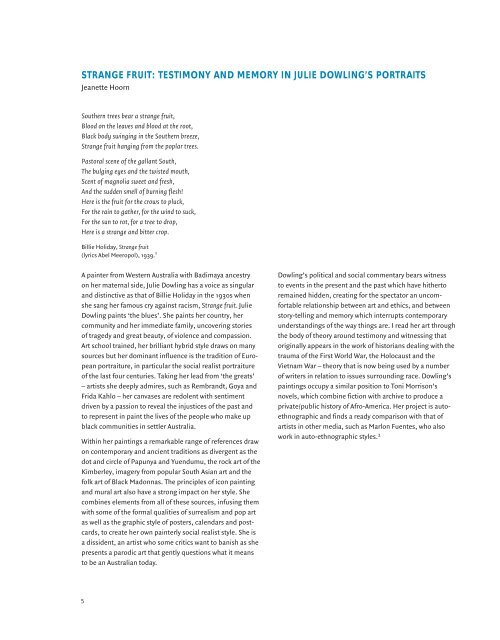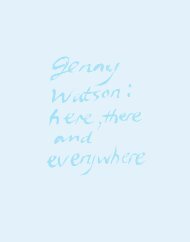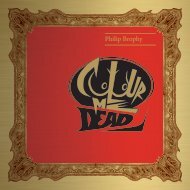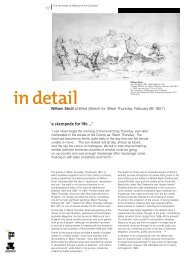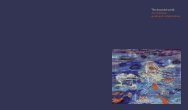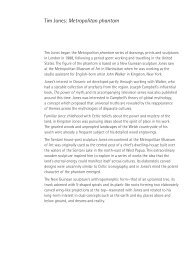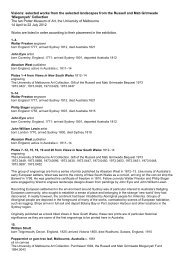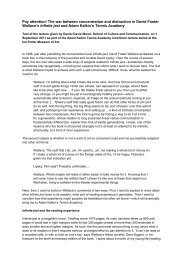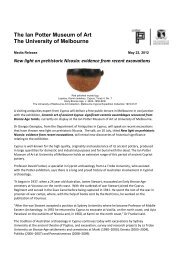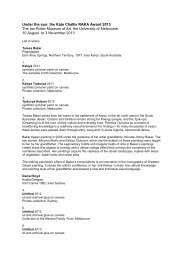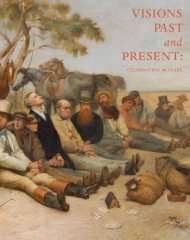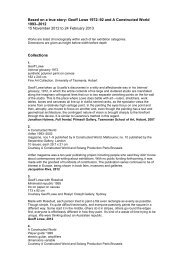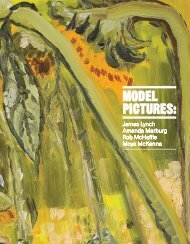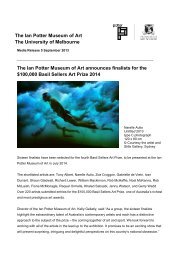STRANGE FRUIT
catalogue - Ian Potter Museum of Art - University of Melbourne
catalogue - Ian Potter Museum of Art - University of Melbourne
- No tags were found...
You also want an ePaper? Increase the reach of your titles
YUMPU automatically turns print PDFs into web optimized ePapers that Google loves.
<strong>STRANGE</strong> <strong>FRUIT</strong>: TESTIMONY AND MEMORY IN JULIE DOWLING’S PORTRAITS<br />
Jeanette Hoorn<br />
Southern trees bear a strange fruit,<br />
Blood on the leaves and blood at the root,<br />
Black body swinging in the Southern breeze,<br />
Strange fruit hanging from the poplar trees.<br />
Pastoral scene of the gallant South,<br />
The bulging eyes and the twisted mouth,<br />
Scent of magnolia sweet and fresh,<br />
And the sudden smell of burning flesh!<br />
Here is the fruit for the crows to pluck,<br />
For the rain to gather, for the wind to suck,<br />
For the sun to rot, for a tree to drop,<br />
Here is a strange and bitter crop.<br />
Billie Holiday, Strange fruit<br />
(lyrics Abel Meeropol), 1939. 1<br />
A painter from Western Australia with Badimaya ancestry<br />
on her maternal side, Julie Dowling has a voice as singular<br />
and distinctive as that of Billie Holiday in the 1930s when<br />
she sang her famous cry against racism, Strange fruit. Julie<br />
Dowling paints ‘the blues’. She paints her country, her<br />
community and her immediate family, uncovering stories<br />
of tragedy and great beauty, of violence and compassion.<br />
Art school trained, her brilliant hybrid style draws on many<br />
sources but her dominant influence is the tradition of European<br />
portraiture, in particular the social realist portraiture<br />
of the last four centuries. Taking her lead from ‘the greats’<br />
– artists she deeply admires, such as Rembrandt, Goya and<br />
Frida Kahlo – her canvases are redolent with sentiment<br />
driven by a passion to reveal the injustices of the past and<br />
to represent in paint the lives of the people who make up<br />
black communities in settler Australia.<br />
Within her paintings a remarkable range of references draw<br />
on contemporary and ancient traditions as divergent as the<br />
dot and circle of Papunya and Yuendumu, the rock art of the<br />
Kimberley, imagery from popular South Asian art and the<br />
folk art of Black Madonnas. The principles of icon painting<br />
and mural art also have a strong impact on her style. She<br />
combines elements from all of these sources, infusing them<br />
with some of the formal qualities of surrealism and pop art<br />
as well as the graphic style of posters, calendars and postcards,<br />
to create her own painterly social realist style. She is<br />
a dissident, an artist who some critics want to banish as she<br />
presents a parodic art that gently questions what it means<br />
to be an Australian today.<br />
Dowling’s political and social commentary bears witness<br />
to events in the present and the past which have hitherto<br />
remained hidden, creating for the spectator an uncomfortable<br />
relationship between art and ethics, and between<br />
story-telling and memory which interrupts contemporary<br />
understandings of the way things are. I read her art through<br />
the body of theory around testimony and witnessing that<br />
originally appears in the work of historians dealing with the<br />
trauma of the First World War, the Holocaust and the<br />
Vietnam War – theory that is now being used by a number<br />
of writers in relation to issues surrounding race. Dowling’s<br />
paintings occupy a similar position to Toni Morrison’s<br />
novels, which combine fiction with archive to produce a<br />
private/public history of Afro-America. Her project is autoethnographic<br />
and finds a ready comparison with that of<br />
artists in other media, such as Marlon Fuentes, who also<br />
work in auto-ethnographic styles. 2<br />
5


